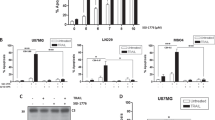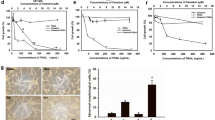Abstract
Patients with malignant gliomas have a poor prognosis and new treatment paradigms are needed against this disease. TRAIL/Apo2L selectively induces apoptosis in malignant cells sparing normal cells and is hence of interest as a potential therapeutic agent against gliomas. To determine the factors that modulate sensitivity to TRAIL, we examined the differences in TRAIL-activated signaling pathways in glioma cells with variable sensitivities to the agent. Apoptosis in response to TRAIL was unrelated to DR5 expression or endogenous p53 status in a panel of 8 glioma cell lines. TRAIL activated the extrinsic (cleavage of caspase-8, caspase-3 and PARP) and mitochondrial apoptotic pathways and reduced FLIP levels. It also induced caspase-dependent JNK activation, which did not influence TRAIL-induced apoptosis. Because the pro-survival PI3K/Akt pathway is highly relevant to gliomas, we assessed whether Akt could protect against TRAIL-induced apoptosis. Pretreatment with SH-6, a novel Akt inhibitor, enhanced TRAIL-induced apoptosis, suggesting a protective role for Akt. Conversely, TRAIL induced caspase-dependent cleavage of Akt neutralizing its anti-apoptotic effects. These results demonstrate that TRAIL-induced apoptosis in gliomas involves both activation of death pathways and downregulation of survival pathways. Additional studies are warranted to determine the therapeutic potential of TRAIL against gliomas.
Similar content being viewed by others
References
Golstein P. Cell death: TRAIL and its receptors. Curr Biol 1997; 7: R750–R753.
Schneider P, Thome M, Burns K, et al. TRAIL receptors 1 (DR4) and 2 (DR5) signal FADD-dependent apoptosis and activate NF-κB. Immunity 1997; 7: 831–836.
Sprick MR, Rieser E, Stahl H, Grosse-Wilde A, Weigand MA, Walczak H. Caspase-10 is recruited to and activated at the native TRAIL and CD95 death-inducing signaling complexes in a FADD-dependent manner but can not functionally substitute caspase-8. The EMBO J 2002; 21: 4520–4530.
Wajant H, Johannes FJ, Haas E, et al. Dominant-negative FADD inhibits TNFR60-, Fas/Apo1- and TRAIL-R/Apo2- mediated cell death but not gene induction. Curr Biol 1998; 8: 113–116.
Yamada H, Tada-Oikawa S, Uchida A, Kawanishi S. TRAIL Causes Cleavage of Bid by Caspase-8 and Loss of Mitochondrial Membrane Potential Resulting in Apoptosis in BJAB Cells. Biochem Biophys Res Commun 1999; 265: 130–133.
Suliman A, Lam A, Datta R, Srivastava RK. Intracellular mechanisms of TRAIL: Apoptosis through mitochondrial-dependent and- independent pathways. Oncogene 2001; 20: 2122–2133.
Deng Y, Lin Y, Wu X. TRAIL-induced apoptosis requires Bax-dependent mitochondrial release of Smac/DIABLO. Genes Develop 2002; 16: 33–45.
Pan G, Ni J, Wei YF, Yu G, Gentz R, Dixit VM. An antagonist decoy receptor and a death domain-containing receptor for TRAIL. Science 1997; 277: 815–818.
Marsters SA, Sheridan JP, Pitti RM, et al. A novel receptor for Apo2L/TRAIL contains a truncated death domain. Curr Biol 1997; 7: 1003–1006.
Griffith TS, Chin WA, Jackson GC, Lynch DH, Kubin MZ. Intracellular regulation of TRAIL-induced apoptosis in human melanoma cells. J Immunol 1998; 161: 2833–2840.
Mitsiades N, Poulaki V, Mitsiades C, Tsokos M. Ewing’s Sarcoma Family Tumors Are Sensitive to Tumor Necrosis Factor-related Apoptosis-inducing Ligand and Express Death Receptor 4 and Death Receptor 5. Cancer Res 2001; 61: 2704–2712.
Hao C, Beguinot F, Condorelli G, et al. Induction and Intracellular Regulation of Tumor Necrosis Factor-related Apoptosis-inducing Ligand (TRAIL) Mediated Apotosis in Human Malignant Glioma Cells. Cancer Res 2001; 61: 1162–1170.
Marsters SA, Pitti RA, Sheridan JP, Ashkenazi A. Control of apoptosis signaling by Apo2 ligand. Recent Prog Horm Res 1999; 54: 225–234.
Sheridan JP, Marsters SA, Pitti RM, et al. Control of TRAIL-induced apoptosis by a family of signaling and decoy receptors. Science 1997; 277: 818–821.
Ashkenazi A, Pai RC, Fong S, et al. Safety and antitumor activity of recombinant soluble Apo2 ligand. J Clin Invest 1999; 104: 155–162.
Walczak H, Miller RE, Ariail K, et al. Tumoricidal activity of tumor necrosis factor-related apoptosis- inducing ligand in vivo. Nat Med 1999; 5: 157–163.
Kozikowski AP, Sun H, Brognard J, Dennis PA. Novel PI analogues selectively block activation of the pro-survival serine/threonine kinase Akt. J Am Chem Soc 2003; 125: 1144–1145.
Rokudai S, Fujita N, Hashimoto Y, Tsuruo T. Cleavage and inactivation of antiapoptotic Akt/PKB by caspases during apoptosis. J Cell Physiol 2000; 182: 290–296.
Scaffidi C, Schmitz I, Krammer PH, Peter ME. The role of c-FLIP in modulation of CD95-induced apoptosis. J Biol Chem 1999; 274: 1541–1548.
Chen YR, Wang X, Templeton D, Davis RJ, Tan TH. The Role of c-Jun N-terminal Kinase (JNK) in Apoptosis Induced by Ultraviolet C and gamma Radiation. Duration of JNK activation may determine cell death and proliferation. J Biol Chem 1996; 271: 31929–31936.
Kharbanda S, Ren R, Pandey P, et al. Activation of the c-Abl tyrosine kinase in the stress response to DNA-damaging agents. Nature 1995; 376: 785–788.
Chen X, Thakkar H, Tyan F, et al. Constitutively active Akt is an important regulator of TRAIL sensitivity in prostate cancer. Oncogene 2001; 20: 6073–6083.
Secchiero P, Gonelli A, Carnevale E, et al. TRAIL Promotes the Survival and Proliferation of Primary Human Vascular Endothelial Cells by Activating the Akt and ERK Pathways. Circulation 2003; 107: 2250–2256.
Kandasamy K, Srivastava RK. Role of the Phosphatidylinositol 3′-Kinase/PTEN/Akt Kinase Pathway in Tumor Necrosis Factor-related Apoptosis-inducing Ligand-induced Apoptosis in Non-Small Cell Lung Cancer Cells. Cancer Res 2002; 62: 4929–4937.
Zinda MJ, Vlahos CJ, Lai MT. Ceramide induces the dephosphorylation and inhibition of constitutively activated Akt in PTEN negative U87mg cells. Biochem Biophys Res Commun 2001; 280: 1107–1115.
Bachelder RE, Wendt MA, Fujita N, Tsuruo T, Mercurio AM. The Cleavage of Akt/Protein Kinase B by Death Receptor Signaling Is an Important Event in Detachment-induced Apoptosis. J Biol Chem 2001; 276: 34702–34707.
Wilson DJ, Fortner KA, Lynch DH, et al. JNK, but not MAPK, activation is associated with Fas-mediated apoptosis in human T cells. Eur J Immunol 1996; 26: 989–994.
Herr I, Wilhelm D, Bohler T, Angel P, Debatin KM. JNK/SAPK activity is not sufficient for anticancer therapy-induced apoptosis involving CD95-L, TRAIL and TNF-alpha. Int J Cancer 1999; 80: 417–424.
Fukazawa T, Fujiwara T, Morimoto Y, et al. Differential involvement of the CD95 (Fas/APO-1) receptor/ligand system on apoptosis induced by the wild-type p53 gene transfer in human cancer cells. Oncogene 1999; 18: 2189–2199.
Rokhlin OW, Gudkov AV, Kwek S, Glover RA, Gewies AS, Cohen MB. p53 is involved in tumor necrosis factor-alpha-induced apoptosis in the human prostatic carcinoma cell line LNCaP. Oncogene 2000; 19: 1959–1968.
Reles A, Wen WH, Schmider A, et al. Correlation of p53 Mutations with Resistance to Platinum-based Chemotherapy and Shortened Survival in Ovarian Cancer. Clinical Cancer Research 2001; 7: 2984–2997.
Haas-Kogan DA, Kogan SS, Yount G, et al. p53 function influences the effect of fractionated radiotherapy on glioblastoma tumors. Int J Radiat Oncol Biol Phys 1999; 43: 399–403.
Sheikh MS, Burns TF, Huang Y, et al. p53-dependent and -independent regulation of the death receptor KILLER/DR5 gene expression in response to genotoxic stress and tumor necrosis factor alpha. Cancer Res 1998; 58: 1593–1598.
Fulci G, Labuhn M, Maier D, et al. p53 gene mutation and ink4a-arf deletion appear to be two mutually exclusive events in human glioblastoma. Oncogene 2000; 19: 3816–3822.
Xiao C, Yang BF, Asadi N, Beguinot F, Hao C. Tumor Necrosis Factor-related Apoptosis-inducing Ligand-induced Death-inducing Signaling Complex and Its Modulation by c-FLIP and PED/PEA-15 in Glioma Cells. J Biol Chem 2002; 277: 25020–25025.
Panka DJ, Mano T, Suhara T, Walsh K, Mier JW. Phosphatidylinositol 3-Kinase/Akt Activity Regulates c-FLIP Expression in Tumor Cells. J Biol Chem 2001; 276: 6893–6896.
Mitsiades N, Mitsiades CS, Poulaki V, Anderson KC, Treon SP. Intracellular regulation of tumor necrosis factor-related apoptosis-inducing ligand-induced apoptosis in human multiple myeloma cells. Blood 2002; 99: 2162–2171.
Leverkus M, Neumann M, Mengling T, et al. Regulation of Tumor Necrosis Factor-related Apoptosis-inducing Ligand Sensitivity in Primary and Transformed Human Keratinocytes. Cancer Res 2000; 60: 553–559.
Franke TF, Kaplan DR, Cantley LC. PI3K: Downstream AKTion blocks apoptosis. Cell 1997; 88: 435–437.
Bowers DC, Fan S, Walter KA, et al. Scatter Factor/Hepatocyte Growth Factor Protects against Cytotoxic Death in Human Glioblastoma via Phosphatidylinositol 3-Kinase- and AKT-dependent Pathways. Cancer Res 2000; 60: 4277–4283.
Datta SR, Dudek H, Tao X, et al. Akt phosphorylation of BAD couples survival signals to the cell-intrinsic death machinery. Cell 1997; 91: 231–241.
Cardone MH, Roy N, Stennicke HR, et al. Regulation of Cell Death Protease Caspase-9 by Phosphorylation. Science 1998; 282: 1318–1321.
Schlegel J, Piontek G, Budde B, Neff F, Kraus A. The Akt/protein kinase B-dependent anti-apoptotic pathway and the mitogen-activated protein kinase cascade are alternatively activated in human glioblastoma multiforme. Cancer Lett 2000; 158: 103–108.
Martin D, Salinas M, Fujita N, Tsuruo T, Cuadrado A. Ceramide and Reactive Oxygen Species Generated by H2O2 Induce Caspase-3-independent Degradation of Akt/Protein Kinase B. J Biol Chem 2002; 277: 42943–42952.
Sluss HK, Barrett T, Derijard B, Davis RJ. Signal transduction by tumor necrosis factor mediated by JNK protein kinases. Mol Cell Biol 1994; 14: 8376–8384.
Cahill MA, Peter ME, Kischkel FC, et al. CD95 (APO-1/Fas) induces activation of SAP kinases downstream of ICE-like proteases. Oncogene 1996; 13: 2087–2096.
Adler V, Fuchs SY, Kim J, et al. jun-NH2-terminal kinase activation mediated by UV-induced DNA lesions in melanoma and fibroblast cells. Cell Growth Differ 1995; 6: 1437– 1446.
Verheij M, Bose R, Lin XH, et al. Requirement for ceramide-initiated SAPK/JNK signalling in stress- induced apoptosis. Nature 1996; 380: 75–79.
Eilers A, Whitfield J, Babij C, Rubin LL, Ham J. Role of the Jun kinase pathway in the regulation of c-Jun expression and apoptosis in sympathetic neurons. J Neurosci 1998; 18: 1713–1724.
Zanke BW, Boudreau K, Rubie E, et al. The stress-activated protein kinase pathway mediates cell death following injury induced by cis-platinum, UV irradiation or heat. Curr Biol 1996; 6: 606–613.
Roulston A, Reinhard C, Amiri P, Williams LT. Early Activation of c-Jun N-terminal Kinase and p38 Kinase Regulate Cell Survival in Response to Tumor Necrosis Factor alpha. J Biol Chem 1998; 273: 10232–10239.
Herr I, Wilhelm D, Meyer E, Jeremias I, Angel P, Debatin KM. JNK/SAPK activity contributes to TRAIL-induced apoptosis. Cell Death Differ 1999; 6: 130–135.
Low W, Smith A, Ashworth A, Collins M. JNK activation is not required for Fas-mediated apoptosis. Oncogene 1999; 18: 3737–3741.
Author information
Authors and Affiliations
Corresponding author
Additional information
Supported in part by the NIH grant PO1 CA55261
Rights and permissions
About this article
Cite this article
Puduvalli, V.K., Sampath, D., Bruner, J.M. et al. TRAIL-induced apoptosis in gliomas is enhanced by Akt-inhibition and is independent of JNK activation. Apoptosis 10, 233–243 (2005). https://doi.org/10.1007/s10495-005-6078-3
Issue Date:
DOI: https://doi.org/10.1007/s10495-005-6078-3




